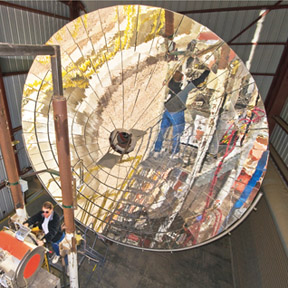
Sandia researchers working on the Sunshine to Petrol project believe they are only weeks away from having a working device that can recycle carbon dioxide into carbon monoxide, a key building block in making combustible fuels such as methanol, gasoline, diesel, and jet fuel. Initially the invention will split water into oxygen and hydrogen, and later it will be tested to split carbon dioxide into carbon monoxide and oxygen.
“We have proven the concept in the laboratory in batch mode, but soon expect to do it in our prototype,” says researcher Jim Miller (1815), who is working with a large multidisciplinary team to come up with an efficient and affordable way to recycle carbon dioxide and turn it back into liquid transportation fuels.
The prototype device that is on the verge of making history is the Counter Rotating Ring Receiver Reactor Recuperator (CR5, for short), invented by Rich Diver (6337) as a way to break down water into hydrogen and oxygen gases. Jim, working with Rich and Nate Siegel (6337), saw the possibility of using the CR5 to break down carbon dioxide, just as it would water, but into carbon monoxide and oxygen.
The CR5 breaks a carbon-oxygen bond in the carbon dioxide to form carbon monoxide and oxygen in two distinct steps. Energy to break down the carbon dioxide comes from sunlight.
“People have known for a long time that theoretically it should be possible to recycle carbon dioxide, but most still think it cannot be made practical, either technically or economically,” says Ellen Stechel (6339), the program manager for the Sandia team.
Hence, only a handful of companies and scientists have pursued the process with much vigor.
Ellen named the Sandia process of effectively reversing combustion by capturing and then converting carbon dioxide and water with concentrated solar energy into liquid hydrocarbon fuels Sunshine to Petrol (S2P). She notes the invention and S2P, which is probably 15 to 20 years away from being market-ready, hold real promise of being able to reduce carbon dioxide emissions while preserving options for the domestic production of liquid fuels. The invention will result in fossil fuels being used at least twice.
As an example, coal would be burned at a clean coal power plant. The carbon dioxide released by burning coal would be captured at the source and reduced to carbon monoxide in the CR5. The carbon monoxide would then be the starting point of making gasoline, jet fuel, methanol, or almost any type of liquid fuel.
The prospect of a liquid hydrocarbon fuel is significant because it fits in with the current gasoline and oil infrastructure. After a liquid synthetic fuel is made from the carbon monoxide, it could be transported through a pipeline or put in a truck and hauled to a gas station or, if necessary, to a refinery for further processing. Plus the final fuel product would work in ordinary gasoline and diesel engine vehicles, including vehicles already on the road.
Nate says that while the first step would be to capture the carbon dioxide from sources where it is concentrated, the ultimate goal would be to snatch it out of the air. An S2P system that includes atmospheric carbon dioxide capture could produce carbon-neutral liquid hydrocarbon fuels.
Rich says he hand-built the precision prototype CR5 in a shop at Sandia’s National Solar Thermal Test Facility and is now doing final calibration to get a working device.
While Rich begins tests on this first-generation prototype, other members of the team are experimenting with the reactive materials that make the device work. They aim to better understand the chemistry of the process and to find materials that will work better and longer.
Other team members, using data from ongoing experiments, are developing models to guide future experiments. Their goal is to predict the performance and recommend changes to make improvements to the CR5 as well as the full S2P system
“It’s a very exciting team,” Ellen says. “We have enough talent and diversity to substantially increase the odds for success in what is a very challenging endeavor.”
The team is deliberately assembled from many organizations across Sandia in both New Mexico and California and includes collaborators in a number of universities across the country. The team also incorporates a board of external advisors.
Success, says Ellen, will consist of continuously improved generations of prototypes and S2P systems, a new generation every three years with significant improvements in performance (measured as the amount of solar energy converted into the fuel), greater durability, and reduced cost. With that schedule of improvements, the technology should be market-ready in less than two decades.
“For a concept as new as the CR5 and Sunshine to Petrol, that would be an aggressive schedule,” Ellen says. “Indeed, developing a sunshine-driven process that can efficiently, cost-effectively, and sustainably take the products of combustion, carbon dioxide and water, and recreate liquid fuels would be an unparalleled achievement. Surmounting this challenge would go a long way toward solving the intertwined problems of finding domestic substitutes for petroleum and mitigating the risk of climate change.”